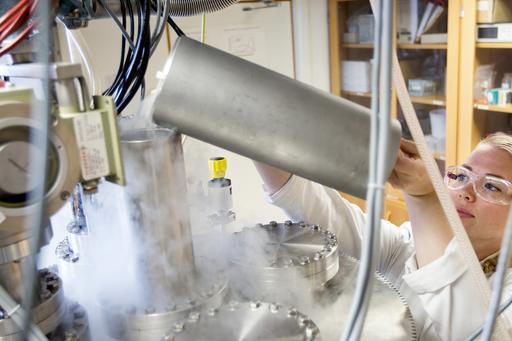
Atmospheric Science
Atmospheric science investigates fundamental atmospheric chemistry and physics processes and how this affects ecosystems, air quality, health and climate. Our studies on a molecular level contribute to a better understanding of transport and reaction processes in the atmosphere.
Our studies of aerosols, atmospheric surfaces and cloud forming particles are important for understanding the evolution of the atmosphere and the Earth’s climate. Our research contributes to fundamental knowledge in scientific areas such as colloidal chemistry, nanotechnology, medicine and sustainable development.
Our researchers come from a wide range of backgrounds - chemistry, physics, geoscience and ecosystems - and have inter- and transdisciplinary collaborations within several external networks such as:
- Gothenburg Air and Climate Network (GAC)
- Gothenburg Center for Sustainability Development (GMV)
- Private organizations and businesses, for instance RISE and AstraZeneca
- Public organisations such as IVL Swedish environmental research institute and the City of Gothenburg.

We perform our research in unique laboratories with advanced equipment such as molecular beam spectrometers and flow tube reactors, and we participate in measurement campaigns in order to characterize specific parts of the atmosphere.
Research Topics
Aerosol, cloud and climate interactions
Organic aerosol, particles, ice crystals and water droplets are all important for cloud formation; and their surfaces are fundamental to atmospheric chemistry and physics. Since clouds are essential for the development of the climate, it is important to strengthen the understanding of the clouds’ impact on chemical and physical processes in the atmosphere.
Air quality
Our research endeavours to identify and fill the knowledge gaps regarding air quality and its impact on our quality of life.
Energy and transport
To ensure a sustainable future, we need to understand how emissions from the energy and transport sectors, and their subsequent atmospheric transformation, affects the composition of the air, our health, ecosystem and climate. Our research focusses on the chemical and physical properties of fuels and emissions.
Photochemistry
Photochemical smog affects the properties of aerosol particles. For example, transformation of soot can alter water uptake and cloud formation. To better understand the atmospheric chemistry within photochemical smog, we study complex oxidation mechanisms for organic compounds that contribute to the formation of secondary organic aerosols (SOA).
Research projects
Research groups
Johan Boman, Professor Emeritus of Atmospheric Science
Research in the intersection of environmental science, physics and chemistry. Focus on air and life quality in urban areas in low and middle-income countries.
Read more

Mattias Hallquist, Professor of Atmospheric Chemistry
Atmospheric particles and their properties from a molecular perspective, spanning from in lab experiments of aerosol formation based on oxidation of organic compounds to field measurements of urban aerosols.
Read more

Xiangrui Kong, Researcher in Atmospheric Science
A new surface-catalyzed mechanism on aerosol surfaces has been discovered (Kong et al. Science 2021). Now, Xiangrui Kong's group is trying to deepen the understanding of this mechanism, as well as quantifying it and evaluating its significance in the atmosphere.
Ravi Kant Pathak, Senior Lecturer in Atmospheric Chemistry
Fundamental understanding of the interactions between soot and organic aerosols in the atmosphere, and the formation, transformation, properties and chemistry of resulting coatings on the soot particles. Investigating the molecular processes relevant for the regional brown haze including biomass burning. Further, investigating emission of neurotoxins from wood combustion.
Read more
Jan Pettersson, Professor of Environmental Atmospheric Science
Fundamental laboratory-based and theoretical studies to improve our conceptual understanding of key aerosol processes, including formation of particles, formation of cloud droplets and ice particles, and the heterogeneous chemistry taking place on these particles.
Read more
Erik Thomson, Professor of Experimental Atmospheric Chemistry
Fundamental chemical and physical processes related to atmospheric phase transitions including the formation and evolution of ice and snow.
Read more
Cheng Wu, Researcher in Atmospheric Chemistry
The atmospheric fate of volatile organic compounds and their impacts on air quality and climate change, with a special interest in development and use of advanced sampling and detection techniques and data-driven analytical approaches.
Read more
Research for sustainable development
Atmospheric science research touches on many of the UN's global sustainability goals. Our research is important to understand many of the challenges that affect sustainable agriculture, our health, the use of fossil fuel-based energy, the development of urban environments, ecosystems and climate.
Some examples:
- According to WHO, every nine death worldwide can be linked to air pollution.
- Changing climate and precipitation patterns can alter agricultural productivity, the access to clean water, the sustainability of society and, in extreme cases, trigger mass migrations and conflicts.
A better understanding of the basic processes that create air pollution, change the formation and the properties of clouds, and processes that force chemical transformations are examples of areas where atmospheric science research can contribute to global solutions, now and in the future.